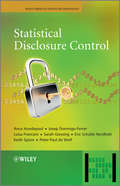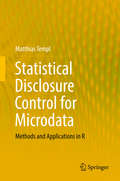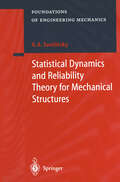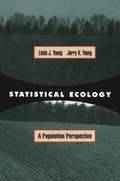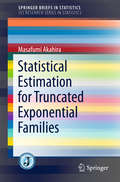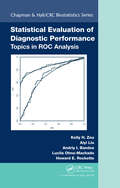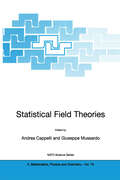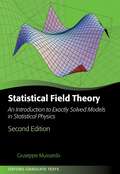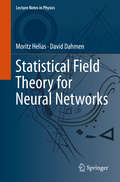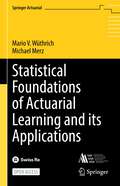- Table View
- List View
Statistical Disclosure Control (Wiley Series in Survey Methodology)
by Anco Hundepool Josep Domingo-Ferrer Luisa Franconi Sarah Giessing Eric Schulte Nordholt Keith Spicer Peter-Paul de WolfA reference to answer all your statistical confidentiality questions. This handbook provides technical guidance on statistical disclosure control and on how to approach the problem of balancing the need to provide users with statistical outputs and the need to protect the confidentiality of respondents. Statistical disclosure control is combined with other tools such as administrative, legal and IT in order to define a proper data dissemination strategy based on a risk management approach. The key concepts of statistical disclosure control are presented, along with the methodology and software that can be used to apply various methods of statistical disclosure control. Numerous examples and guidelines are also featured to illustrate the topics covered. Statistical Disclosure Control: Presents a combination of both theoretical and practical solutions Introduces all the key concepts and definitions involved with statistical disclosure control. Provides a high level overview of how to approach problems associated with confidentiality. Provides a broad-ranging review of the methods available to control disclosure. Explains the subtleties of group disclosure control. Features examples throughout the book along with case studies demonstrating how particular methods are used. Discusses microdata, magnitude and frequency tabular data, and remote access issues. Written by experts within leading National Statistical Institutes. Official statisticians, academics and market researchers who need to be informed and make decisions on disclosure limitation will benefit from this book.
Statistical Disclosure Control (Wiley Series in Survey Methodology)
by Anco Hundepool Josep Domingo-Ferrer Luisa Franconi Sarah Giessing Eric Schulte Nordholt Keith Spicer Peter-Paul de WolfA reference to answer all your statistical confidentiality questions. This handbook provides technical guidance on statistical disclosure control and on how to approach the problem of balancing the need to provide users with statistical outputs and the need to protect the confidentiality of respondents. Statistical disclosure control is combined with other tools such as administrative, legal and IT in order to define a proper data dissemination strategy based on a risk management approach. The key concepts of statistical disclosure control are presented, along with the methodology and software that can be used to apply various methods of statistical disclosure control. Numerous examples and guidelines are also featured to illustrate the topics covered. Statistical Disclosure Control: Presents a combination of both theoretical and practical solutions Introduces all the key concepts and definitions involved with statistical disclosure control. Provides a high level overview of how to approach problems associated with confidentiality. Provides a broad-ranging review of the methods available to control disclosure. Explains the subtleties of group disclosure control. Features examples throughout the book along with case studies demonstrating how particular methods are used. Discusses microdata, magnitude and frequency tabular data, and remote access issues. Written by experts within leading National Statistical Institutes. Official statisticians, academics and market researchers who need to be informed and make decisions on disclosure limitation will benefit from this book.
Statistical Disclosure Control for Microdata: Methods and Applications in R
by Matthias TemplThis book on statistical disclosure control presents the theory, applications and software implementation of the traditional approach to (micro)data anonymization, including data perturbation methods, disclosure risk, data utility, information loss and methods for simulating synthetic data. Introducing readers to the R packages sdcMicro and simPop, the book also features numerous examples and exercises with solutions, as well as case studies with real-world data, accompanied by the underlying R code to allow readers to reproduce all results. The demand for and volume of data from surveys, registers or other sources containing sensible information on persons or enterprises have increased significantly over the last several years. At the same time, privacy protection principles and regulations have imposed restrictions on the access and use of individual data. Proper and secure microdata dissemination calls for the application of statistical disclosure control methods to the data before release. This book is intended for practitioners at statistical agencies and other national and international organizations that deal with confidential data. It will also be interesting for researchers working in statistical disclosure control and the health sciences.
Statistical Disclosure Control in Practice (Lecture Notes in Statistics #111)
by Leon Willenborg Ton de WaalThe aim of this book is to discuss various aspects associated with disseminating personal or business data collected in censuses or surveys or copied from administrative sources. The problem is to present the data in such a form that they are useful for statistical research and to provide sufficient protection for the individuals or businesses to whom the data refer. The major part of this book is concerned with how to define the disclosure problem and how to deal with it in practical circumstances.
Statistical Distributions (Wiley Series In Probability And Statistics - Applied Probability And Statistics Section Ser.)
by Catherine Forbes Merran Evans Nicholas Hastings Brian PeacockA new edition of the trusted guide on commonly used statistical distributions Fully updated to reflect the latest developments on the topic, Statistical Distributions, Fourth Edition continues to serve as an authoritative guide on the application of statistical methods to research across various disciplines. The book provides a concise presentation of popular statistical distributions along with the necessary knowledge for their successful use in data modeling and analysis. Following a basic introduction, forty popular distributions are outlined in individual chapters that are complete with related facts and formulas. Reflecting the latest changes and trends in statistical distribution theory, the Fourth Edition features: A new chapter on queuing formulas that discusses standard formulas that often arise from simple queuing systems Methods for extending independent modeling schemes to the dependent case, covering techniques for generating complex distributions from simple distributions New coverage of conditional probability, including conditional expectations and joint and marginal distributions Commonly used tables associated with the normal (Gaussian), student-t, F and chi-square distributions Additional reviewing methods for the estimation of unknown parameters, such as the method of percentiles, the method of moments, maximum likelihood inference, and Bayesian inference Statistical Distributions, Fourth Edition is an excellent supplement for upper-undergraduate and graduate level courses on the topic. It is also a valuable reference for researchers and practitioners in the fields of engineering, economics, operations research, and the social sciences who conduct statistical analyses.
Statistical Distributions
by Catherine Forbes Merran Evans Nicholas Hastings Brian PeacockA new edition of the trusted guide on commonly used statistical distributions Fully updated to reflect the latest developments on the topic, Statistical Distributions, Fourth Edition continues to serve as an authoritative guide on the application of statistical methods to research across various disciplines. The book provides a concise presentation of popular statistical distributions along with the necessary knowledge for their successful use in data modeling and analysis. Following a basic introduction, forty popular distributions are outlined in individual chapters that are complete with related facts and formulas. Reflecting the latest changes and trends in statistical distribution theory, the Fourth Edition features: A new chapter on queuing formulas that discusses standard formulas that often arise from simple queuing systems Methods for extending independent modeling schemes to the dependent case, covering techniques for generating complex distributions from simple distributions New coverage of conditional probability, including conditional expectations and joint and marginal distributions Commonly used tables associated with the normal (Gaussian), student-t, F and chi-square distributions Additional reviewing methods for the estimation of unknown parameters, such as the method of percentiles, the method of moments, maximum likelihood inference, and Bayesian inference Statistical Distributions, Fourth Edition is an excellent supplement for upper-undergraduate and graduate level courses on the topic. It is also a valuable reference for researchers and practitioners in the fields of engineering, economics, operations research, and the social sciences who conduct statistical analyses.
Statistical Distributions: Applications and Parameter Estimates
by Nick T. ThomopoulosThis book gives a description of the group of statistical distributions that have ample application to studies in statistics and probability. Understanding statistical distributions is fundamental for researchers in almost all disciplines. The informed researcher will select the statistical distribution that best fits the data in the study at hand. Some of the distributions are well known to the general researcher and are in use in a wide variety of ways. Other useful distributions are less understood and are not in common use. The book describes when and how to apply each of the distributions in research studies, with a goal to identify the distribution that best applies to the study. The distributions are for continuous, discrete, and bivariate random variables. In most studies, the parameter values are not known a priori, and sample data is needed to estimate parameter values. In other scenarios, no sample data is available, and the researcher seeks some insight that allows the estimate of the parameter values to be gained. This handbook of statistical distributions provides a working knowledge of applying common and uncommon statistical distributions in research studies. These nineteen distributions are: continuous uniform, exponential, Erlang, gamma, beta, Weibull, normal, lognormal, left-truncated normal, right-truncated normal, triangular, discrete uniform, binomial, geometric, Pascal, Poisson, hyper-geometric, bivariate normal, and bivariate lognormal. Some are from continuous data and others are from discrete and bivariate data. This group of statistical distributions has ample application to studies in statistics and probability and practical use in real situations. Additionally, this book explains computing the cumulative probability of each distribution and estimating the parameter values either with sample data or without sample data. Examples are provided throughout to guide the reader. Accuracy in choosing and applying statistical distributions is particularly imperative for anyone who does statistical and probability analysis, including management scientists, market researchers, engineers, mathematicians, physicists, chemists, economists, social science researchers, and students in many disciplines.
Statistical Distributions in Scientific Work: Volume 5 — Inferential Problems and Properties (Nato Science Series C: #79)
by Charles Taillie Ganapati P. Patil Bruno A. BaldessariProceedings of the NATO Advanced Study Institute, Trieste, Italy, July 10-August 1, 1980
Statistical Distributions in Scientific Work: Volume 4 — Models, Structures, and Characterizations, Proceedings of the NATO Advanced Study Institute held at the Università degli Studi di Trieste, Trieste, Italy, July 10 – August 1, 1980 (Nato Science Series C: #79)
by Charles Taillie Ganapati P. Patil Bruno A. BaldessariProceedings of the NATO Advanced Study Institute, Trieste, Italy, July 10-August 1, 1980
Statistical DNA Forensics: Theory, Methods and Computation (Statistics in Practice)
by Wing Kam Fung Yue-Qing HuStatistical methodology plays a key role in ensuring that DNA evidence is collected, interpreted, analyzed and presented correctly. With the recent advances in computer technology, this methodology is more complex than ever before. There are a growing number of books in the area but none are devoted to the computational analysis of evidence. This book presents the methodology of statistical DNA forensics with an emphasis on the use of computational techniques to analyze and interpret forensic evidence.
Statistical Dynamics and Reliability Theory for Mechanical Structures (Foundations of Engineering Mechanics)
by Valery A. SvetlitskyThe monograph text is based on lectures delivered by author during many years for students of Applied Iechanics Department of Bauman Ioscow State Technical University. The monograph includes also analitical results of scientific research obtained in collaboration with industry. Progress in developing new equipment has called for a better understand ing of the physical peculiarities pertaining to the action of designed structures in real conditions. This is necessary for increasing the accuracy of the analysis and making these structures more reliable. It has been found that classical determined perturbations are not principal and that determinism-based methods of classical mechanics prove insufficient for understanding and explaining physical effects that arise at the operation of instruments located on moving objects, the vibration of rocket engines, the motion of a vehicle, and the action of wind and seismic loads. Therefore the necessity arose for devising a new physical model to analyze these dynamic processes and, in particular, for creating a new mathematical apparatus that would allow us to take into account non-deterministic external excitations. The theory of random processes that had been developed well enough as applied to problems of radio engineering and automatic control, where the effect produced by random excitations appeared to be commensurable with that of deterministic excitations and where the ignoring of the random ex citations would bring about incorrect results, became such an apparatus.
The Statistical Dynamics of Turbulence
by Jovan JovanovicThis short but complicated book is very demanding of any reader. The scope and style employed preserve the nature of its subject: the turbulence phe nomena in gas and liquid flows which are believed to occur at sufficiently high Reynolds numbers. Since at first glance the field of interest is chaotic, time-dependent and three-dimensional, spread over a wide range of scales, sta tistical treatment is convenient rather than a description of fine details which are not of importance in the first place. When coupled to the basic conserva tion laws of fluid flow, such treatment, however, leads to an unclosed system of equations: a consequence termed, in the scientific community, the closure problem. This is the central and still unresolved issue of turbulence which emphasizes its chief peculiarity: our inability to do reliable predictions even on the global flow behavior. The book attempts to cope with this difficult task by introducing promising mathematical tools which permit an insight into the basic mechanisms involved. The prime objective is to shed enough light, but not necessarily the entire truth, on the turbulence closure problem. For many applications it is sufficient to know the direction in which to go and what to do in order to arrive at a fast and practical solution at minimum cost. The book is not written for easy and attractive reading.
Statistical Ecology
by Linda J. Young Jerry YoungCovering a wide range of disciplines, this book explains the formulae, techniques, and methods used in field ecology. By providing an awareness of the statistical foundation for existing methods, the book will make biologists more aware of the strengths and possible weaknesses of procedures employed, and statisticians more appreciative of the needs of the field ecologist. Unique to this book is a focus on ecological data for single-species populations, from sampling through modeling. Examples come from real situations in pest management, forestry, wildlife biology, plant protection, and environmental studies, as well as from classical ecology. All those using this book will acquire a strong foundation in the statistical methods of modern ecological research. This textbook is for late undergraduate and graduate students, and for professionals.
Statistical Electromagnetics
by Richard HollandThis book addresses the problem of treating interior responses of complex electronic enclosures or systems, and presents a probabilistic approach. Relationships for determining the statistics of the driving fields to apply to a circuit analysis code representing part of an enclosed system's writing are worked out. Also addressed are limited spatial and frequency coherence essential to a statistically based field drive model. This text gives examples, different modeling, and describes how to make, interchange, and optimize models.
Statistical Electromagnetics
by Richard HollandThis book addresses the problem of treating interior responses of complex electronic enclosures or systems, and presents a probabilistic approach. Relationships for determining the statistics of the driving fields to apply to a circuit analysis code representing part of an enclosed system's writing are worked out. Also addressed are limited spatial and frequency coherence essential to a statistically based field drive model. This text gives examples, different modeling, and describes how to make, interchange, and optimize models.
Statistical Estimation: Asymptotic Theory (Stochastic Modelling and Applied Probability #16)
by I.A. Ibragimov R.Z. Has'minskiiwhen certain parameters in the problem tend to limiting values (for example, when the sample size increases indefinitely, the intensity of the noise ap proaches zero, etc.) To address the problem of asymptotically optimal estimators consider the following important case. Let X 1, X 2, ... , X n be independent observations with the joint probability density !(x,O) (with respect to the Lebesgue measure on the real line) which depends on the unknown patameter o e 9 c R1. It is required to derive the best (asymptotically) estimator 0:( X b ... , X n) of the parameter O. The first question which arises in connection with this problem is how to compare different estimators or, equivalently, how to assess their quality, in terms of the mean square deviation from the parameter or perhaps in some other way. The presently accepted approach to this problem, resulting from A. Wald's contributions, is as follows: introduce a nonnegative function w(0l> ( ), Ob Oe 9 (the loss function) and given two estimators Of and O! n 2 2 the estimator for which the expected loss (risk) Eown(Oj, 0), j = 1 or 2, is smallest is called the better with respect to Wn at point 0 (here EoO is the expectation evaluated under the assumption that the true value of the parameter is 0). Obviously, such a method of comparison is not without its defects.
Statistical Estimation for Truncated Exponential Families (SpringerBriefs in Statistics)
by Masafumi AkahiraThis book presents new findings on nonregular statistical estimation. Unlike other books on this topic, its major emphasis is on helping readers understand the meaning and implications of both regularity and irregularity through a certain family of distributions. In particular, it focuses on a truncated exponential family of distributions with a natural parameter and truncation parameter as a typical nonregular family. This focus includes the (truncated) Pareto distribution, which is widely used in various fields such as finance, physics, hydrology, geology, astronomy, and other disciplines. The family is essential in that it links both regular and nonregular distributions, as it becomes a regular exponential family if the truncation parameter is known. The emphasis is on presenting new results on the maximum likelihood estimation of a natural parameter or truncation parameter if one of them is a nuisance parameter. In order to obtain more information on the truncation, the Bayesian approach is also considered. Further, the application to some useful truncated distributions is discussed. The illustrated clarification of the nonregular structure provides researchers and practitioners with a solid basis for further research and applications.
Statistical Estimation of Epidemiological Risk (Statistics in Practice)
by Kung-Jong LuiStatistical Estimation of Epidemiological Risk provides coverage of the most important epidemiological indices, and includes recent developments in the field. A useful reference source for biostatisticians and epidemiologists working in disease prevention, as the chapters are self-contained and feature numerous real examples. It has been written at a level suitable for public health professionals with a limited knowledge of statistics. Other key features include: Provides comprehensive coverage of the key epidemiological indices. Includes coverage of various sampling methods, and pointers to where each should be used. Includes up-to-date references and recent developments in the field. Features many real examples, emphasising the practical nature of the book. Each chapter is self-contained, allowing the book to be used as a useful reference source. Includes exercises, enabling use as a course text.
Statistical Evaluation of Diagnostic Performance: Topics in ROC Analysis
by Kelly H. Zou Aiyi Liu Andriy I. Bandos Lucila Ohno-Machado Howard E. RocketteStatistical evaluation of diagnostic performance in general and Receiver Operating Characteristic (ROC) analysis in particular are important for assessing the performance of medical tests and statistical classifiers, as well as for evaluating predictive models or algorithms. This book presents innovative approaches in ROC analysis, which are releva
Statistical Extremes and Applications (Nato Science Series C: #131)
by J. Tiago De OliveiraThe first references to statistical extremes may perhaps be found in the Genesis (The Bible, vol. I): the largest age of Methu'selah and the concrete applications faced by Noah-- the long rain, the large flood, the structural safety of the ark --. But as the pre-history of the area can be considered to last to the first quarter of our century, we can say that Statistical Extremes emer ged in the last half-century. It began with the paper by Dodd in 1923, followed quickly by the papers of Fre-chet in 1927 and Fisher and Tippett in 1928, after by the papers by de Finetti in 1932, by Gumbel in 1935 and by von Mises in 1936, to cite the more relevant; the first complete frame in what regards probabilistic problems is due to Gnedenko in 1943. And by that time Extremes begin to explode not only in what regards applications (floods, breaking strength of materials, gusts of wind, etc. ) but also in areas going from Proba bility to Stochastic Processes, from Multivariate Structures to Statistical Decision. The history, after the first essential steps, can't be written in few pages: the narrow and shallow stream gained momentum and is now a huge river, enlarging at every moment and flooding the margins. Statistical Extremes is, thus, a clear-cut field of Probability and Statistics and a new exploding area for research.
Statistical Factor Analysis and Related Methods: Theory and Applications (Wiley Series in Probability and Statistics #418)
by Alexander T. BasilevskyStatistical Factor Analysis and Related Methods Theory andApplications In bridging the gap between the mathematical andstatistical theory of factor analysis, this new work represents thefirst unified treatment of the theory and practice of factoranalysis and latent variable models. It focuses on such areasas: * The classical principal components model and sample-populationinference * Several extensions and modifications of principal components,including Q and three-mode analysis and principal components in thecomplex domain * Maximum likelihood and weighted factor models, factoridentification, factor rotation, and the estimation of factorscores * The use of factor models in conjunction with various types ofdata including time series, spatial data, rank orders, and nominalvariable * Applications of factor models to the estimation of functionalforms and to least squares of regression estimators
Statistical Field Theories (NATO Science Series II: Mathematics, Physics and Chemistry #73)
by Andrea Cappelli Giuseppe MussardoRecent developments in theoretical physics include new instances of the unification of quite different phenomena. The theoretical community is challenged by the growing interactions between high-energy physics, statistical physics, and condensed matter physics. The common language, though, is exact solutions of two-dimensional and conformable field theories. This volume is a faithful representation of this interdisciplinary domain. Conformable and integrable field theories have been active research topics for several decades. The main recent developments concern the boundary effects and applications to disordered systems. The number of applications of the exact methods to condensed-matter problems has been growing over the years. Nowadays it is widely recognized that strongly interacting systems in low dimensions can be successfully described by integrable and conformable theories. This volume is an indispensable aid to those seeking to find their way in this domain.
Statistical Field Theory: An Introduction to Exactly Solved Models in Statistical Physics (Oxford Graduate Texts)
by Giuseppe MussardoFundamental concepts of phase transitions, such as order parameters, spontaneous symmetry breaking, scaling transformations, conformal symmetry and anomalous dimensions, have deeply changed the modern vision of many areas of physics, leading to remarkable developments in statistical mechanics, elementary particle theory, condensed matter physics and string theory. This self-contained book provides a thorough introduction to the fascinating world of phase transitions and frontier topics of exactly solved models in statistical mechanics and quantum field theory, such as renormalization groups, conformal models, quantum integrable systems, duality, elastic S-matrices, thermodynamic Bethe ansatz and form factor theory. The clear discussion of physical principles is accompanied by a detailed analysis of several branches of mathematics distinguished for their elegance and beauty, including infinite dimensional algebras, conformal mappings, integral equations and modular functions. Besides advanced research themes, the book also covers many basic topics in statistical mechanics, quantum field theory and theoretical physics. Each argument is discussed in great detail while providing overall coherent understanding of physical phenomena. Mathematical background is made available in supplements at the end of each chapter, when appropriate. The chapters include problems of different levels of difficulty. Advanced undergraduate and graduate students will find this book a rich and challenging source for improving their skills and for attaining a comprehensive understanding of the many facets of the subject.
Statistical Field Theory for Neural Networks (Lecture Notes in Physics #970)
by Moritz Helias David DahmenThis book presents a self-contained introduction to techniques from field theory applied to stochastic and collective dynamics in neuronal networks. These powerful analytical techniques, which are well established in other fields of physics, are the basis of current developments and offer solutions to pressing open problems in theoretical neuroscience and also machine learning. They enable a systematic and quantitative understanding of the dynamics in recurrent and stochastic neuronal networks. This book is intended for physicists, mathematicians, and computer scientists and it is designed for self-study by researchers who want to enter the field or as the main text for a one semester course at advanced undergraduate or graduate level. The theoretical concepts presented in this book are systematically developed from the very beginning, which only requires basic knowledge of analysis and linear algebra.
Statistical Foundations of Actuarial Learning and its Applications (Springer Actuarial)
by Mario V. Wüthrich Michael MerzThis open access book discusses the statistical modeling of insurance problems, a process which comprises data collection, data analysis and statistical model building to forecast insured events that may happen in the future. It presents the mathematical foundations behind these fundamental statistical concepts and how they can be applied in daily actuarial practice. Statistical modeling has a wide range of applications, and, depending on the application, the theoretical aspects may be weighted differently: here the main focus is on prediction rather than explanation. Starting with a presentation of state-of-the-art actuarial models, such as generalized linear models, the book then dives into modern machine learning tools such as neural networks and text recognition to improve predictive modeling with complex features. Providing practitioners with detailed guidance on how to apply machine learning methods to real-world data sets, and how to interpret the results without losing sight of the mathematical assumptions on which these methods are based, the book can serve as a modern basis for an actuarial education syllabus.
